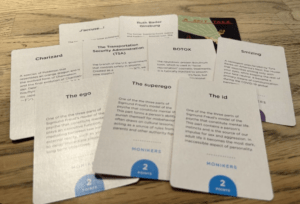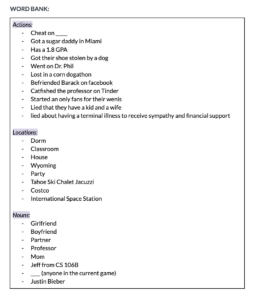Introduction
Taboo is a team competition guessing game created by the Parker Brothers. It is available through physical cards as well as online through an unofficial website and targets parties of 4-10 with ages 12+. The objective of Taboo is for a player to guess the word their partner has on their card without mentioning the word or the five additional words that are also listed on the card.
Central Argument
Taboo is similar to our game in that they are both team competition guessing games. However, they are different in that Taboo is merely a guessing game, meaning the focus is on communication constraints, and creative thinking/interpretation. Our game on the other side, incorporates this guessing aspect with social deduction, creating a game that involves role playing, deception, shared vs. unshared knowledge along with dynamics that also occur in a guessing game.
Analysis
When it comes to mechanics, Taboo has two teams. This mechanic effectively creates a sense of camaraderie between teams which makes the game more enjoyable; players are able to bond with their team members. When it comes to our game, we also have the concept of teams, but instead of having 2 we have 3 that have different roles. We tested our game with different numbers of players for each role, and we found that situations where competition becomes unilateral made our game burdensome and unenjoyable for the player that is left out. Additionally, teams in Taboo only interact with players of their team. There is no sense of actual interaction with the teams they are competing against. This can create a dynamic where players aren’t really “bonding” or learning more about players that aren’t in their team. I found that when playing Taboo, I felt closer and more connected to my team member, while I didn’t feel any sense of getting to know who the players in other teams where. Our game is different in that everyone can interact with each other. Since we do have teams, this makes it so players that are in the same team feel connected, but there is also a sense of connection between players in other team because there is actual direct interaction. This direct interaction between players from different teams fosters a more dynamic and engaging social experience compared to games like Taboo where interaction is limited to within one’s own team.
When playing Taboo, I found that after going through a few rounds, it actually got boring. This is mainly due to Taboo’s word selections. The words provided are very generic and impersonal, thus after the novelty of the game wears off, it loses its charm. What I saw was a game that lacked aesthetic emphasis. Though the mechanics are very simple and approachable, Taboo’s lack of aesthetic expression created an experience that wasn’t immersive—there were no aspects of role-playing, storytelling, or personality.




On the other hand, I also played Monikers, which made use of more complex interesting phrases which made the playing experience way more enjoyable.

When it comes to our game, we decided to go with a concept that relies on the theme of “fake friends.” Due to this aesthetic choice, and how it mimics the social mechanisms of gossiping, we were able to create a game that is inherently more engaging. We went with outrageous stories, and more personal topics that could seem real, thus manifesting an immersive experience. Additionally, our game relies on guessing a full storyline rather than a singular word. Furthermore, since our game has the inclusion of roles, this creates extra restrictions when it comes to what is said/unsaid. One main mechanic our game includes is how we have 3 different roles for players: real friends, fake friends, and enemies. Real friends try to glean the story from the storyteller, who is the person in charge of making the story with words that are provided for them. Fake friends try to tell the enemies what the story is. Enemies try to obtain the story from the storyteller. Due to these mechanisms, interesting dynamics arise in that players will be more strategic with how they try to convey the storyline, because ultimately, if the enemies obtain the story they win.

Taboo also makes use of short rounds that last 60 seconds. This time restraint is very effective in creating a sense of urgency for players. However, something about this time restraint is that it creates a dynamic where players are mainly blurting as many things as possible in order to convey what the word is rather than being strategic. I think that in the context of Taboo, this works due to how words are simple, generic, and short—quicker rounds are needed to account for this. However, in the context of our game, due to how our secret words are actually storylines and how it is a social deduction game as well, we made our rounds longer. This allows an opportunity for players to be strategic and not feel too overwhelmed.


